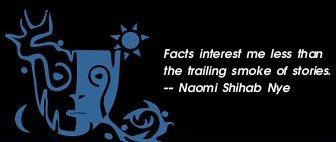|

Myth
© 2006 Terri Windling, used by permission
[Images: "Donkeyskin", Little Red", "Medicine Vision", and "The Muse" by Terri Windling]
"Myth must be kept alive. The people who can keep it alive are the artists of one kind or another. The function of the artist is the mythologization of the environment and the world."
— Joseph Campbell
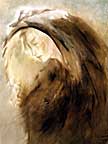 Growing up in northeastern America, I was raised as American children often are, on the myths and fairy tales of Europe. As I grew, so did my appreciation of old wives tales passed down through generations of storytellers — for just as nightly dreams reflect the realities of our waking life, the symbols found in folklore and myth (the collective dreams of entire cultures) provide useful metaphors for the journeys, struggles and transformations we encounter in modern life. So deep-rooted was my love of myth that I went on to study the subject in college, with a particular interest in the role of women in oral and literary fairy tales. Although I then spent a decade in New York City, I found myself repeatedly drawn to the British Isles — and eventually I moved to a small country village in Devon, where I've lived ever since. Growing up in northeastern America, I was raised as American children often are, on the myths and fairy tales of Europe. As I grew, so did my appreciation of old wives tales passed down through generations of storytellers — for just as nightly dreams reflect the realities of our waking life, the symbols found in folklore and myth (the collective dreams of entire cultures) provide useful metaphors for the journeys, struggles and transformations we encounter in modern life. So deep-rooted was my love of myth that I went on to study the subject in college, with a particular interest in the role of women in oral and literary fairy tales. Although I then spent a decade in New York City, I found myself repeatedly drawn to the British Isles — and eventually I moved to a small country village in Devon, where I've lived ever since.
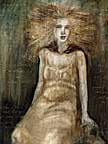 But just as I was preparing to move to England, a curious thing happened. Through a long chain of circumstances I found myself in the sun-bleached desert of Arizona — a world away from the misty moors and green woodlands of Devon. In the desert, I came to appreciate the myths and legends of my own heritage: a unique mix of Native American tales and the transplanted folklore of immigrant cultures from all around the world — a peculiarly American "melting pot" of ancient folkways and stories. Wandering through the spirited desert hills, I came to truly understand how the land itself shapes mythic imagery — and how, as an artist, to let the land speak through me with its own voice. For many years now, I've divided my time between my home in Devon and a winter retreat in the Arizona desert. Both of these landscapes, and the stories they contain, are the source of inspiration for my work. But just as I was preparing to move to England, a curious thing happened. Through a long chain of circumstances I found myself in the sun-bleached desert of Arizona — a world away from the misty moors and green woodlands of Devon. In the desert, I came to appreciate the myths and legends of my own heritage: a unique mix of Native American tales and the transplanted folklore of immigrant cultures from all around the world — a peculiarly American "melting pot" of ancient folkways and stories. Wandering through the spirited desert hills, I came to truly understand how the land itself shapes mythic imagery — and how, as an artist, to let the land speak through me with its own voice. For many years now, I've divided my time between my home in Devon and a winter retreat in the Arizona desert. Both of these landscapes, and the stories they contain, are the source of inspiration for my work.
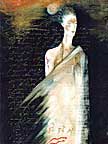 In Devon, my subject matter has been drawn from European fairy tales — exploring the ways that these familiar stories (particularly in their oldest, darkest versions) can be used as a poetic language to explore the shadows of the human psyche. Classic stories like Cinderella, Red Riding Hood, Snow White, Bluebeard, Sleeping Beauty, The Armless Maiden, and Donkeyskin have much to say on the subjects of heroism and transformation; about how one finds the courage to fight and prevail against overwhelming odds. I find collage to be a satisfying medium for working with fairy tale imagery, for it allows me to combine my paintings and drawings with odds-and-ends of fairy tale text pinned and stitched onto the page, bringing "old wives' tales" together with other arts traditional to women: spinning, sewing, lace-making...a bit of this and a bit of that...just as cooks create soup, and as women through the centuries have created their lives. In Devon, my subject matter has been drawn from European fairy tales — exploring the ways that these familiar stories (particularly in their oldest, darkest versions) can be used as a poetic language to explore the shadows of the human psyche. Classic stories like Cinderella, Red Riding Hood, Snow White, Bluebeard, Sleeping Beauty, The Armless Maiden, and Donkeyskin have much to say on the subjects of heroism and transformation; about how one finds the courage to fight and prevail against overwhelming odds. I find collage to be a satisfying medium for working with fairy tale imagery, for it allows me to combine my paintings and drawings with odds-and-ends of fairy tale text pinned and stitched onto the page, bringing "old wives' tales" together with other arts traditional to women: spinning, sewing, lace-making...a bit of this and a bit of that...just as cooks create soup, and as women through the centuries have created their lives.
In Arizona, my subject matter has been drawn from animist imagery found in the Mexican, Native, and Anglo folk tales common to the region. Although inspired by the land itself, these pictures tend to be figurative ones, blending the human form with elements of desert flora and fauna. Certain motifs are used in symbolic ways. Figures with clothes half on, half off, are caught in moments of transformation — shedding their human consciousness, or returning to it from a primal animal state. Eyes blinded or concealed are eyes that look into the Wilderness World: the realm of spirits and ancestors, of visions, dreams, and inward journeys. Woundedness symbolizes the importance of acknowledging the difficult passages of life, as opposed to fearing, repressing or ignoring them; celebrating the strength and wisdom that comes from hard experience. Words scratched and inked onto the paintings are not meant to be quite legible, but rather to evoke ancient stories distantly recalled and half-forgotten.
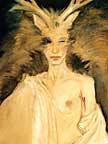
Why do we continue to be enspelled by folk stories and fairy tales, after all these years? Why do we continue to tell the same old tales, over and over again? I think it's because these stories are not just fantasy; they're about real life. We've all encountered wicked wolves, found fairy godmothers, and faced trial by fire. We've all set off into unknown woods at one point in life or another. We've all had to learn to tell friend from foe, and to be kind to crones by the side of the road. Our lives are our mythic journeys, and our happy endings are still to be won.
Terri Windling, is a writer, folklorist, and consulting editor for Tor Books. She is best known for her editorial work in the field of fantasy literature, where she has long been a passionate advocate of mythic fiction. She has published over forty books, including The Wood Wife (a mythic novel set in contemporary Tucson, Arizona), The Winter Child (a mythic novel set in contemporary Tucson, Arizona), The Winter Child (a picture book with artist Wendy Froud), the six-volume Snow White, Blood Red series (literary fairy tales for adult readers) and The Armless Maiden (literary fairy tales addressing the subject of child abuse) — as well as short stories, children's fiction, and the annual The Year's Best Fantasy & Horror (a picture book with artist Wendy Froud), the six-volume Snow White, Blood Red series (literary fairy tales for adult readers) and The Armless Maiden (literary fairy tales addressing the subject of child abuse) — as well as short stories, children's fiction, and the annual The Year's Best Fantasy & Horror volumes (with horror editor Ellen Datlow). Her essays on myth, fairy tales, and art have appeared in Realms of Fantasy magazine, and in books including Mirror, Mirror on the Wall: Women Writers Explore Their Favorite Fairy Tales volumes (with horror editor Ellen Datlow). Her essays on myth, fairy tales, and art have appeared in Realms of Fantasy magazine, and in books including Mirror, Mirror on the Wall: Women Writers Explore Their Favorite Fairy Tales (Expanded Edition), and Meditations on Middle-Earth, and Fées. Windling has won six World Fantasy Awards, and the 1997 Mythopoeic Award for Novel of the Year. Also an accomplished artist, Windling creates "folkloric" paintings inspired by myth, fairy tales, and women's history. Her art has been exhibited in galleries and museums in the U.S. and abroad. In 1987, Windling created the Endicott Studio, and in 2001 she co-created Endicott West (an arts retreat in Arizona) with Ellen Kushner and Delia Sherman. She is a founding member of the Interstitial Arts Foundation.. (Expanded Edition), and Meditations on Middle-Earth, and Fées. Windling has won six World Fantasy Awards, and the 1997 Mythopoeic Award for Novel of the Year. Also an accomplished artist, Windling creates "folkloric" paintings inspired by myth, fairy tales, and women's history. Her art has been exhibited in galleries and museums in the U.S. and abroad. In 1987, Windling created the Endicott Studio, and in 2001 she co-created Endicott West (an arts retreat in Arizona) with Ellen Kushner and Delia Sherman. She is a founding member of the Interstitial Arts Foundation..
Return to Mythic Passages Menu
Subscribe to the Mythic Passages e-zine
|
